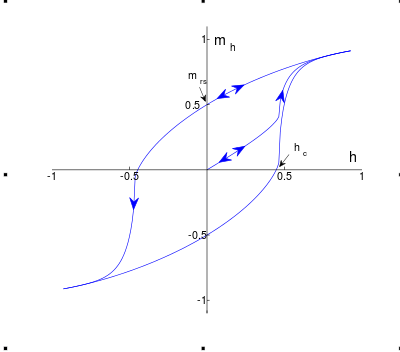Magnetic hysteresis

When an external magnetic field is applied to a ferromagnet such as iron, the atomic dipoles align themselves with it. Even when the field is removed, part of the alignment will be retained: the material has become magnetized. Once magnetized, the magnet will stay magnetized indefinitely. To demagnetize it requires heat or a magnetic field in the opposite direction. This is the effect that provides the element of memory in a hard disk drive.
The relationship between field strength H and magnetization M is not linear in such materials. If a magnet is demagnetized (H=M=0) and the relationship between H and M is plotted for increasing levels of field strength, M follows the initial magnetization curve. This curve increases rapidly at first and then approaches an asymptote called magnetic saturation. If the magnetic field is now reduced monotonically, M follows a different curve. At zero field strength, the magnetization is offset from the origin by an amount called the remanence. If the H-M relationship is plotted for all strengths of applied magnetic field the result is a hysteresis loop called the main loop. The width of the middle section is twice the coercivity of the material.[1](Chapter 1)
A closer look at a magnetization curve generally reveals a series of small, random jumps in magnetization called Barkhausen jumps. This effect is due to crystallographic defects such as dislocations.[1](Chapter 15)
Magnetic hysteresis loops are not exclusive to materials with ferromagnetic ordering. Other magnetic orderings, such as spin glass ordering, also exhibit this phenomenon.[2]
Physical origin
The phenomenon of hysteresis in ferromagnetic materials is the result of two effects: rotation of magnetization and changes in size or number of magnetic domains. In general, the magnetization varies (in direction but not magnitude) across a magnet, but in sufficiently small magnets, it doesn't. In these single-domain magnets, the magnetization responds to a magnetic field by rotating. Single-domain magnets are used wherever a strong, stable magnetization is needed (for example, magnetic recording).
Larger magnets are divided into regions called domains. Within each domain, the magnetization does not vary; but between domains are relatively thin domain walls in which the direction of magnetization rotates from the direction of one domain to another. If the magnetic field changes, the walls move, changing the relative sizes of the domains. Because the domains are not magnetized in the same direction, the magnetic moment per unit volume is smaller than it would be in a single-domain magnet; but domain walls involve rotation of only a small part of the magnetization, so it is much easier to change the magnetic moment. The magnetization can also change by addition or subtraction of domains (called nucleation and denucleation).
Models
The most known empirical models in hysteresis are Preisach and Jiles-Atherton models. These models allow an accurate modeling of the hysteresis loop and are widely used in the industry. However, these models lose the connection with thermodynamics and the energy consistency is not ensured. Latest models rely on a consistent thermodynamic formulation. VINCH model[3] is inspired by the kinematic hardening laws and by the thermodynamics of irreversible processes. In particular, in addition to provide an accurate modeling, the stored magnetic energy and the dissipated energy are known at all times. The obtained incremental formulation is variationally consistent, i.e., all internal variables follow from the minimization of a thermodynamic potential. That allows to obtain easily a vectorial model while Preisach and Jiles-Atherton are fundamentally scalar models.
Applications
There are a great variety of applications of the hysteresis in ferromagnets. Many of these make use of their ability to retain a memory, for example magnetic tape, hard disks, and credit cards. In these applications, hard magnets (high coercivity) like iron are desirable so the memory is not easily erased.
Soft magnets (low coercivity) are used as cores in electromagnets. The nonlinear response of the magnetic moment to a magnetic field boosts the response of the coil wrapped around it. The low coercivity reduces that energy loss associated with hysteresis.
Magnetic hysteresis material (soft nickel-iron rods) has been used in damping the angular motion of satellites in low earth orbit since the dawn of the space age. [4]
See also
References
- 1 2 Chikazumi, Sōshin (1997). Physics of ferromagnetism (2nd ed.). Oxford: Oxford University Press. ISBN 9780191569852.
- ↑ Monod, P.; Prejean, J. J.; Tissier, B. (1979). "Magnetic hysteresis of CuMn in the spin glass state". J. Appl. Phys. American Institute of Physics. 50 (B11): 7324. doi:10.1063/1.326943. Retrieved 9 March 2013.
- ↑ Vincent Francois-Lavet et al (2011-11-14). Vectorial Incremental Nonconservative Consistent Hysteresis model.
- ↑ "Magnetic Hysteresis Damping of Satellite Attitude Motion" (PDF). General Electric Spacecraft Department. Retrieved 1 October 2016.